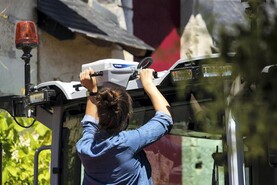I took part in the International Farming Young Exchange to Switzerland for four weeks this summer, living with and learning the culture of farm families there.
My first host family were the Ashbachers in Bern, who have a traditional dairy farm of 23 cows on 24ha.
The cows calve all year round, so there is no dry period.
To protect the cows from high temperatures and maximise grass return, they are kept inside during the day and let out to pasture at night.
My second hosts were the Dilgers in Lucerne. They have a profitable livery business, due to the scarcity of land.
Their farm is 6ha, the typical farm size in Lucerne. Swiss law prevents the division of farms below this size.
On both farms neighbours bought (unpasteurised) milk directly from the farm.
Dairy farmers receive an average 50c/l for milk and premiums are paid for organic milk from hay-fed cows, which is required for certain types of cheese. Because of the small herd size, AI is the primary breeding method.

One of the highlights of my stay was hiking the Morgetepass mountain at 1,959 meters and visiting a traditional Swiss cheese factory on the mountain top. The family's summer house, milking parlour, cheese factory and shop are all under one roof.
Both families also had a fruit and vegetable garden, which is common practice. A lot of people sell fruit and vegetables in self-service, unmanned sheds, on the roadside.
There are many differences between the farming systems in Ireland and Switzerland.
Housed animals are required to have more space, for example.
I helped cut bracken by hand from silage fields because the farms I visited, like many, do not use pesticides
They require a minimum of 0.9 metres squared for pigs and 0.14 metres squared for hens, compared to 0.75 metres squared and 0.11 metres squared in Ireland.
The fields are clean with few weeds; fallen branches and twigs are picked regularly.
I helped cut bracken by hand from silage fields because the farms I visited, like many, do not use pesticides. Many of them also have fields with steep inclines, which requires bespoke machinery to cultivate.
Naming calves
On all farms the calves are all given a name that begins with the first letter of the mother’s name. During my stay I christened my first calf “Madonna”.
Like in Ireland, there is a reliance on family labour due to the high cost, with larger farmers hiring non-nationals to help with the work.
The demand and cost of land remains high, with good land ranging from 60,000 CHF to 80,000 CHF (€54,000 to €72,000) per hectare.

Bryan Tully's exchange to Switzerland.
Many farmers depend on subsidies to make a profit. In contrast to the Irish system, where there is no age limit on receiving subsidies, Swiss farmers do not receive subsidies over the age of 65. This encourages the transfer of farms to the next generation.
One of the highlights of my stay was hiking the Morgetepass mountain at 1,959m and visiting a traditional Swiss cheese factory on the mountaintop.
As with most Swiss farms, it is a family affair with three generations working there
The family’s summer house, milking parlour, cheese factory and shop are all under one roof.
As with most Swiss farms, it is a family affair with three generations working there.
The cows are tethered inside during the day and let out to graze on the mountains at night. A lot of wildflowers grow there, which adds to the flavour of the cheese.
I took part in the International Farming Young Exchange to Switzerland for four weeks this summer, living with and learning the culture of farm families there.
My first host family were the Ashbachers in Bern, who have a traditional dairy farm of 23 cows on 24ha.
The cows calve all year round, so there is no dry period.
To protect the cows from high temperatures and maximise grass return, they are kept inside during the day and let out to pasture at night.
My second hosts were the Dilgers in Lucerne. They have a profitable livery business, due to the scarcity of land.
Their farm is 6ha, the typical farm size in Lucerne. Swiss law prevents the division of farms below this size.
On both farms neighbours bought (unpasteurised) milk directly from the farm.
Dairy farmers receive an average 50c/l for milk and premiums are paid for organic milk from hay-fed cows, which is required for certain types of cheese. Because of the small herd size, AI is the primary breeding method.

One of the highlights of my stay was hiking the Morgetepass mountain at 1,959 meters and visiting a traditional Swiss cheese factory on the mountain top. The family's summer house, milking parlour, cheese factory and shop are all under one roof.
Both families also had a fruit and vegetable garden, which is common practice. A lot of people sell fruit and vegetables in self-service, unmanned sheds, on the roadside.
There are many differences between the farming systems in Ireland and Switzerland.
Housed animals are required to have more space, for example.
I helped cut bracken by hand from silage fields because the farms I visited, like many, do not use pesticides
They require a minimum of 0.9 metres squared for pigs and 0.14 metres squared for hens, compared to 0.75 metres squared and 0.11 metres squared in Ireland.
The fields are clean with few weeds; fallen branches and twigs are picked regularly.
I helped cut bracken by hand from silage fields because the farms I visited, like many, do not use pesticides. Many of them also have fields with steep inclines, which requires bespoke machinery to cultivate.
Naming calves
On all farms the calves are all given a name that begins with the first letter of the mother’s name. During my stay I christened my first calf “Madonna”.
Like in Ireland, there is a reliance on family labour due to the high cost, with larger farmers hiring non-nationals to help with the work.
The demand and cost of land remains high, with good land ranging from 60,000 CHF to 80,000 CHF (€54,000 to €72,000) per hectare.

Bryan Tully's exchange to Switzerland.
Many farmers depend on subsidies to make a profit. In contrast to the Irish system, where there is no age limit on receiving subsidies, Swiss farmers do not receive subsidies over the age of 65. This encourages the transfer of farms to the next generation.
One of the highlights of my stay was hiking the Morgetepass mountain at 1,959m and visiting a traditional Swiss cheese factory on the mountaintop.
As with most Swiss farms, it is a family affair with three generations working there
The family’s summer house, milking parlour, cheese factory and shop are all under one roof.
As with most Swiss farms, it is a family affair with three generations working there.
The cows are tethered inside during the day and let out to graze on the mountains at night. A lot of wildflowers grow there, which adds to the flavour of the cheese.








 This is a subscriber-only article
This is a subscriber-only article









SHARING OPTIONS: